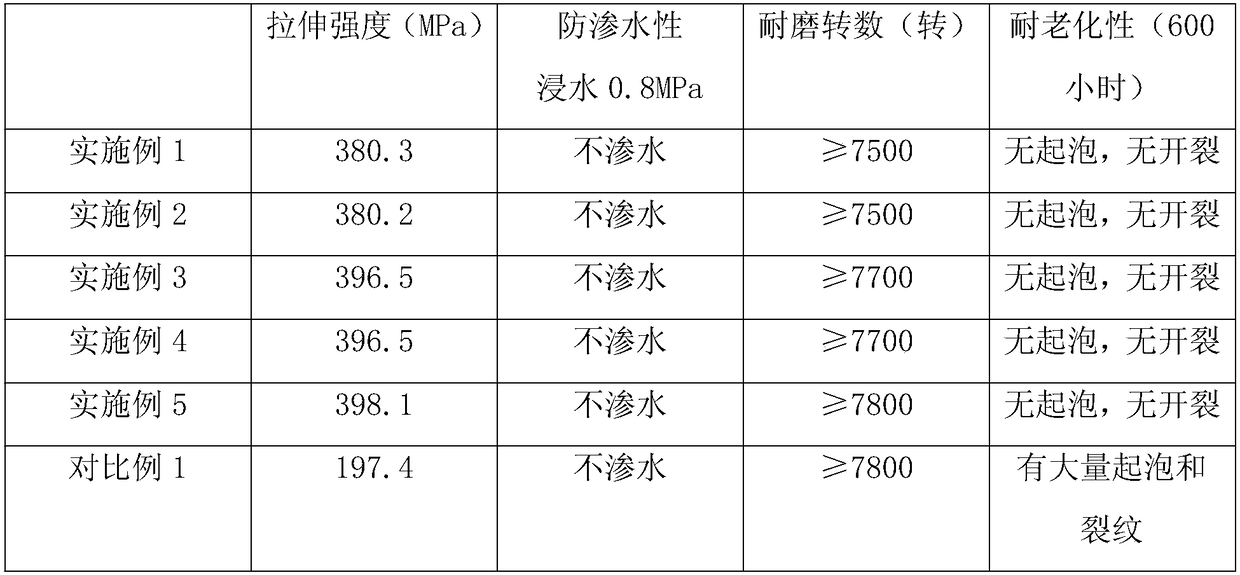Composite for fire hoses and preparation method of composite
A composite material and fire hose technology, applied in the field of fire fighting equipment, can solve the problems of difficult manufacturing, limited leak-proof and pressure resistance, etc., and achieve improved processing performance, good wear resistance and water resistance, and improved waterproof performance. Effect
- Summary
- Abstract
- Description
- Claims
- Application Information
AI Technical Summary
Problems solved by technology
Method used
Image
Examples
Embodiment 1
[0032] A composite material for a fire hose, which is made of the following components by weight: 100 parts of sucrose polyester modified polyvinyl chloride resin, 60 parts of fluorine-containing silicone modified polyurethane polymer, bisphenol A polycarbonate 40 parts of ester, 30 parts of polyphenylene ether, 10 parts of polyacrylamide, 10 parts of acrylate, 10 parts of medium chain triglyceride, 8 parts of polyvinyl acetal, 8 parts of dibutyl phthalate, stearic acid 2 parts calcium, 2 parts cadmium stearate, 1 part 1,4-butanediol diacrylate, 1 part dibutyltin dilaurate.
[0033] Among them, the medium chain triglyceride is saturated caprylic triglyceride.
[0034] The above-mentioned preparation method of a composite material for a fire hose comprises the steps of:
[0035] (1) Mix the calcium stearate and cadmium stearate in the prescribed amount evenly, pour them into medium-chain triglycerides, heat to 70° C., and stir for 20 minutes to obtain mixture A;
[0036] (2) ...
Embodiment 2
[0045] A composite material for a fire hose, which is made of the following components by weight: 100 parts of sucrose polyester modified polyvinyl chloride resin, 70 parts of fluorine-containing silicone modified polyurethane polymer, bisphenol A polycarbonate 50 parts of ester, 40 parts of polyphenylene ether, 15 parts of polyacrylamide, 15 parts of acrylate, 12 parts of medium chain triglyceride, 12 parts of polyvinyl acetal, 12 parts of dibutyl phthalate, stearic acid 3 parts of calcium, 3 parts of cadmium stearate, 2 parts of 1,4-butanediol diacrylate, 2 parts of dibutyltin dilaurate.
[0046] Among them, medium chain triglyceride is saturated capric triglyceride.
[0047] The above-mentioned preparation method of a composite material for a fire hose comprises the steps of:
[0048] (1) Mix the calcium stearate and cadmium stearate in the prescribed amount evenly, pour them into medium-chain triglycerides, heat to 80° C., and stir for 30 minutes to obtain mixture A;
[...
Embodiment 3
[0058] A composite material for a fire hose, which is made of the following components by weight: 100 parts of sucrose polyester modified polyvinyl chloride resin, 60 parts of fluorine-containing silicone modified polyurethane polymer, bisphenol A polycarbonate 50 parts of ester, 30 parts of polyphenylene ether, 15 parts of polyacrylamide, 10 parts of acrylate, 12 parts of medium chain triglyceride, 8 parts of polyvinyl acetal, 12 parts of dibutyl phthalate, stearic acid 2 parts of calcium, 3 parts of cadmium stearate, 1 part of 1,4-butanediol diacrylate, 2 parts of dibutyltin dilaurate.
[0059] Wherein, the medium chain triglyceride is a saturated caprylic acid-capric acid mixed triglyceride, wherein the ratio of caprylic acid to capric acid is 1:0.5.
[0060] The above-mentioned preparation method of a composite material for a fire hose comprises the steps of:
[0061] (1) Mix the calcium stearate and cadmium stearate in the prescribed amount evenly, pour them into medium-...
PUM
 Login to View More
Login to View More Abstract
Description
Claims
Application Information
 Login to View More
Login to View More - R&D
- Intellectual Property
- Life Sciences
- Materials
- Tech Scout
- Unparalleled Data Quality
- Higher Quality Content
- 60% Fewer Hallucinations
Browse by: Latest US Patents, China's latest patents, Technical Efficacy Thesaurus, Application Domain, Technology Topic, Popular Technical Reports.
© 2025 PatSnap. All rights reserved.Legal|Privacy policy|Modern Slavery Act Transparency Statement|Sitemap|About US| Contact US: help@patsnap.com


